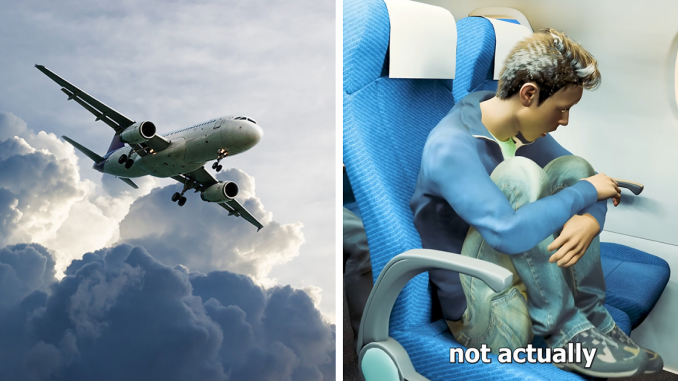
A viral safety simulation has left millions unsettled after showing what happens when passengers adopt the wrong posture during a plane crash.
The short PSA demonstrated in brutal detail what might happen to passengers who curl up into a ball during a crash, as well as those who adopt the proper brace position advised by airlines.
The clip has already been viewed over 43 million times on YouTube alone.
The viral simulation shocked millions online
Image credits: jimbophotoart/Adobe Stock (Not the actual photo)
As could be seen in the video PSA, which was posted by content creator Zack D, curling into a ball actually leaves travelers vulnerable to several serious injuries, while adopting the proper brace position significantly improves survival odds.
To demonstrate, the content creator showed animated passengers experiencing two very different outcomes, according to the New York Post.
Image credits: zackdfilms
One passenger leaned forward in the proper brace position, covering his head as bags tumbled from overhead bins. The luggage hit the passenger and he emerged shaken, but he was otherwise unharmed.
The other passenger curled tightly into a ball and was flung into the cabin ceiling during the impact, before slamming back down and suffering a broken spine.
Image credits: zackdfilms
Viewers were stunned by the stark contrast. One commenter wrote, “Bro showed no mercy to the guy at the end.” Another added, “Bro was a f**king ragdoll at the end.”
While some doubted the realism of the sequence, the underlying message rang clear. Posture in those critical seconds matters in the event of a plane crash.
Image credits: zackdfilms
Zack D, who shares viral videos about a variety of topics with his 23 million YouTube subscribers, emphasized that the brace position minimizes injuries to the head, neck, and spine, areas that are most vulnerable in a violent impact.
Aviation experts have confirmed that the brace position works
The unsettling clip prompted discussion among aviation specialists, who largely backed up its message.
Image credits: zackdfilms
Nick Eades, a retired British Airways captain considered one of the most experienced Boeing 747 pilots, explained that the posture is designed to reduce whiplash and protect vital organs during sudden deceleration.
“You’re just trying to get the body into a position that’s going to suffer the least damage,” he told LADbible, adding that the position prevents passengers from “breaking their necks in a big impact.”
Image credits: zackdfilms
“It’s like whiplash. You’re trying to avoid that sudden movement of the head, which can result in serious injury, if not de*th,” the retired pilot added.
Former pilot and aviation safety expert Dan Bubb, PhD, reassured travelers that they will not be left guessing in a real emergency.
Image credits: zackdfilms
While detailed brace instructions are often omitted from standard safety demonstrations to avoid alarming passengers, they are printed on safety cards and will be verbally reinforced by the crew if needed.
“Should an emergency occur where passengers will need to brace for impact, the flight attendants will be very clear in giving instructions on what to do and how to do it,” Bubb said.
Experts emphasized that survival factors matter during plane crashes too
Other experts have stressed that posture is only one part of the survival equation.
Aviation safety specialist Christine Negroni stated that even the clothes passengers wear during flights could be a factor in survival.
She noted that wearing loose clothing over leggings, which can melt in fires or restrict circulation after an accident, could make a difference.
Image credits: Mentour Pilot
Experts have also cautioned that there is no magic “safest seat” in an aircraft.
While rear seats sometimes offer better chances in nose-first impacts, no single spot guarantees survival.
There are plenty of variables that come into play during plane crashes, after all, such as how quickly fire spreads, or the proximity of passengers from an emergency exit.
Image credits: tonefotografia/Adobe Stock (Not the actual photo)
This proximity actually became the unexpected basis of a slight superstition earlier this year.
Over the summer, one passenger seated in 11A made headlines after being the sole survivor of an Air India crash.
The passenger’s survival in seat 11A resulted in the demand for the “lucky” seat to skyrocket.
Specialists, however, quickly explained that the passenger’s seat just happened to be close to an emergency exit.
Ultimately, experts stress preparedness over superstition: knowing the brace position, counting rows to the nearest exit, and staying calm are the best defenses in a worst-case scenario.
